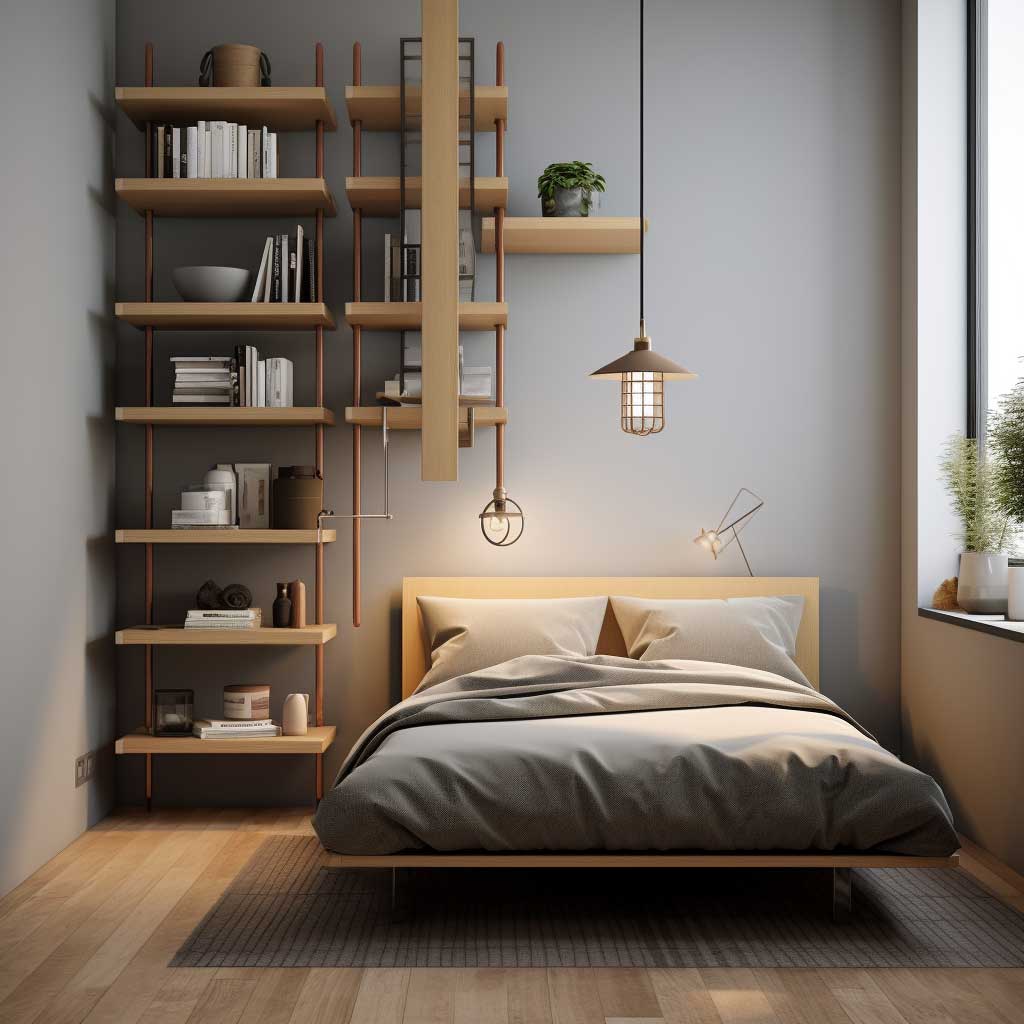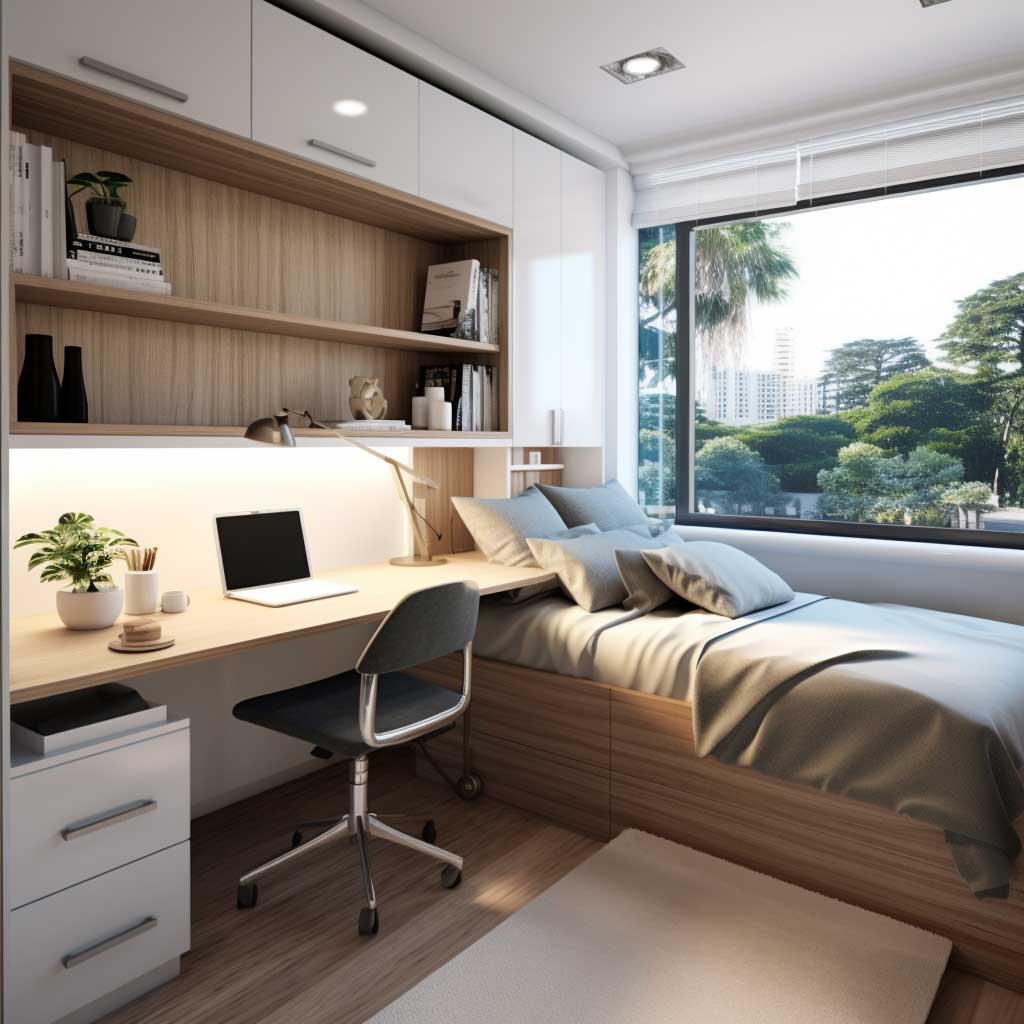In today’s urban living scenarios, space is a luxury. However, a limited area doesn’t mean one has to compromise on style or functionality. With the right strategies and creative approaches, a small bedroom can be transformed into a cozy, efficient, and stylish space. This guide delves into the nuances of small bedroom interior design, offering insights on how to make the most of every square inch.
Maximizing Vertical Space in Small Bedroom Interior Design




The challenge of a small bedroom interior design often revolves around the efficient use of space. While the floor area might be limited, there’s an often overlooked dimension that offers ample opportunity for creativity: the vertical space. By focusing upwards, homeowners can unlock a myriad of design possibilities that not only enhance storage but also elevate the room’s aesthetics.
In urban settings, where space is at a premium, architects and designers have long turned to vertical solutions. Skyscrapers touch the clouds, and in a similar vein, interior spaces, especially small bedrooms, can benefit from this ‘skyward’ approach.
The first step in maximizing vertical space is to assess the room’s height. High ceilings are a boon, but even standard-height rooms offer vertical potential. Wall-mounted shelves are a classic solution. They can run from floor to ceiling, turning an empty wall into a dynamic storage and display area. These shelves can house books, decorative items, or even fold-out desks, ensuring that the floor remains uncluttered.
Lofted beds are another innovative solution. By elevating the bed, the space beneath can serve multiple purposes. It can become a cozy reading nook, a workspace, or even additional storage. This concept is reminiscent of bunk beds but with a more mature and sophisticated twist suitable for adults.
Hanging elements can also be incorporated. Floating nightstands, pendant lights, or even hanging planters can add character to the room without consuming floor space. These elements draw the eye upwards, creating a sense of spaciousness.
Wall hooks and pegboards are other vertical solutions that blend functionality with style. They can hold accessories, jewelry, or even art, turning a plain wall into a functional feature.
The essence of small bedroom interior design lies in innovation. By turning attention to vertical space, homeowners can discover a realm of possibilities that transform their bedrooms from cramped to spacious, from cluttered to organized. It’s a reminder that design solutions need not be bound by the floor’s confines; sometimes, the best answers lie above.
Innovative Storage Solutions for Small Bedroom Designs




Small bedroom interior design often requires a blend of creativity and practicality. One of the primary challenges is storage. With limited space, traditional storage solutions might not suffice. However, with a touch of innovation, even the tiniest bedrooms can boast ample storage without compromising on style.
The bed, being the largest furniture piece in a bedroom, offers significant storage potential. Beds with built-in drawers or storage compartments underneath are a godsend for small spaces. These hidden compartments can store bedding, clothes, or even books, ensuring the room remains clutter-free.
Wall-mounted cabinets are another space-saving solution. When designed with sliding doors or without handles, they offer a sleek look while providing valuable storage. These cabinets can be placed above the bed, turning the often-unused space into a storage hotspot.
Corner spaces, often overlooked, can be transformed into storage areas. Corner shelves or even corner hanging rods can be used to store or display items. Similarly, the space behind doors, usually wasted, can be equipped with hanging organizers or slim shelves, perfect for shoes or accessories.
For those who prefer an open storage look, crates or decorative baskets can be stacked or mounted on walls. Not only do they offer storage, but they also add a rustic or bohemian touch to the room, depending on the chosen style. These containers are perfect for storing blankets, pillows, or even books, making them easily accessible.
Floating nightstands are another innovative storage solution. Instead of traditional bulky nightstands, these wall-mounted alternatives save floor space and offer a modern, minimalistic look. They can house essential items like a lamp, alarm clock, or a book, ensuring the bedside area remains functional.
Under-the-bed storage is not just limited to built-in drawers. Roll-out storage bins or boxes can be used to store items that aren’t frequently accessed, like seasonal clothing or extra bedding. These bins are discreet and can be easily pulled out when needed.
Another often overlooked storage space is the area above the door. A simple shelf placed here can store items that are rarely used, ensuring they are out of the way yet accessible when needed.
Multi-functional furniture pieces are a boon for small bedroom designs. Ottomans that open up to reveal storage or desks with multiple drawers and compartments ensure that every piece of furniture serves more than one purpose, optimizing the available space.
Innovative storage solutions are the cornerstone of effective small bedroom interior design. By thinking outside the box and utilizing every nook and cranny, homeowners can create a space that is both functional and aesthetically pleasing. With the right storage strategies, even the most compact bedrooms can feel organized, spacious, and stylish.
Furniture Choices that Elevate Small Bedroom Interiors




The art of small bedroom interior design lies in the careful selection of furniture. With limited space, every piece must be chosen with both functionality and aesthetics in mind. The right furniture can transform a cramped room into a cozy haven, optimizing space and enhancing the overall ambiance.
The bed, undeniably the focal point of any bedroom, should be chosen with care. For small spaces, platform beds or beds with slim frames can create an illusion of space. As mentioned earlier, beds with built-in storage can serve dual purposes, eliminating the need for additional bulky furniture.
Wall-mounted desks or fold-out desks are perfect for those who need a workspace in their bedroom. When not in use, these desks can be folded back, freeing up floor space. Pairing them with a slim, ergonomic chair ensures comfort without consuming much space.
Wardrobes with sliding doors are ideal for small bedrooms. They eliminate the need for additional space to open doors, and when designed with mirrors, they can make the room appear larger.
Floating or wall-mounted side tables are another excellent choice. They offer the functionality of a traditional nightstand without occupying floor space. When paired with pendant lights or wall-mounted lamps, they create a clean, uncluttered bedside area.
Choosing furniture with exposed legs can also create a sense of space. By allowing sightlines to travel underneath, they reduce visual clutter, making the room feel more open.
Incorporating transparent furniture, like acrylic chairs or glass tables, can further enhance the spacious feel. These pieces, while functional, don’t visually crowd the space, allowing the eye to travel freely.
Furniture choices play a pivotal role in small bedroom interior design. By opting for multi-functional, space-saving, and visually light pieces, homeowners can create a room that feels spacious, organized, and stylish. The key is to prioritize functionality without compromising on aesthetics, ensuring a harmonious blend of both.
The Magic of Mirrors in Small Bedroom Design




Mirrors have long been celebrated for their ability to amplify light and create the illusion of space. In the realm of small bedroom interior design, mirrors are not just decorative elements but powerful tools that can transform the perception of space, making compact rooms feel larger and more inviting.
The reflective properties of mirrors can be harnessed in various ways to enhance a small bedroom. One of the most common techniques is placing a large mirror opposite a window. This not only reflects natural light, brightening up the room, but also creates an illusion of an additional window, making the room feel more expansive.
Beyond the traditional wall-mounted mirrors, mirrored furniture can be a game-changer for small bedrooms. Pieces like mirrored nightstands or dressers reflect the surrounding space, reducing visual clutter. They add a touch of glamour and elegance while ensuring the room feels open and airy.
Ceiling mirrors, though less common, can be a bold choice for those willing to experiment. They draw the eye upwards, emphasizing the room’s height and adding a unique design element. However, it’s essential to ensure that the mirror’s weight is safely supported.
Mirrored wardrobe doors serve a dual purpose. They offer full-length reflection, which is practical, and they also magnify the room’s depth. By reflecting other parts of the room, they create a sense of continuity and spaciousness.
Strategically placing smaller mirrors can also have a significant impact. For instance, a collection of decorative mirrors arranged artistically on a wall can act as a statement piece while enhancing the room’s depth.
It’s not just about the size or number of mirrors, but their placement. Positioning mirrors to reflect focal points, like a piece of art or a decorative wall, can double the impact of that feature, making the room feel more designed and cohesive.
Mirrors, with their magical ability to manipulate perception, are invaluable assets in small bedroom interior design. They not only enhance the room’s aesthetics but also its functionality, making spaces feel brighter and more spacious. By incorporating mirrors thoughtfully, homeowners can create bedrooms that defy their size, offering comfort, style, and a touch of magic.
Optimizing space in a small bedroom is both an art and a science. With thoughtful planning, every corner can be utilized, every design element can serve multiple purposes, and the room can radiate both comfort and style. Remember, it’s not about the size of the space, but how you use it. With the right techniques, even the most compact bedrooms can feel like spacious sanctuaries.












